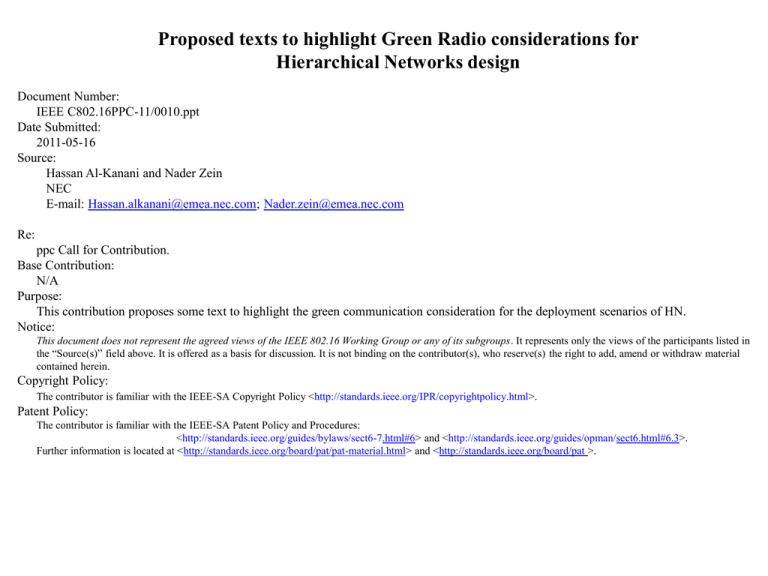Proposed texts to highlight Green Radio considerations for Hierarchical Networks design
advertisement

Proposed texts to highlight Green Radio considerations for Hierarchical Networks design Document Number: IEEE C802.16PPC-11/0010.ppt Date Submitted: 2011-05-16 Source: Hassan Al-Kanani and Nader Zein NEC E-mail: Hassan.alkanani@emea.nec.com; Nader.zein@emea.nec.com Re: ppc Call for Contribution. Base Contribution: N/A Purpose: This contribution proposes some text to highlight the green communication consideration for the deployment scenarios of HN. Notice: This document does not represent the agreed views of the IEEE 802.16 Working Group or any of its subgroups. It represents only the views of the participants listed in the “Source(s)” field above. It is offered as a basis for discussion. It is not binding on the contributor(s), who reserve(s) the right to add, amend or withdraw material contained herein. Copyright Policy: The contributor is familiar with the IEEE-SA Copyright Policy <http://standards.ieee.org/IPR/copyrightpolicy.html>. Patent Policy: The contributor is familiar with the IEEE-SA Patent Policy and Procedures: <http://standards.ieee.org/guides/bylaws/sect6-7.html#6> and <http://standards.ieee.org/guides/opman/sect6.html#6.3>. Further information is located at <http://standards.ieee.org/board/pat/pat-material.html> and <http://standards.ieee.org/board/pat >. 1. Introduction Energy-efficient operation of next-generation networks technologies is a key factor for achieving OPEX reduction and satisfying corporate social responsibility, Today the design of such networks primarily focuses on capacity and coverage optimization while considerations and measures of the power and energy consumption are largely ignored, This contribution briefly highlights the needs to adopt the Green Radio approach to all aspects of overall system development in future networks, Green Radio includes efficient hardware and software platforms and careful integration into SON functions to ensure maximum energy efficiency in different deployment scenarios. 2. Key Drivers for Green Radio • ~60% of Mobile carrier’s TCO is Operation Expenditures (OPEX) • Power consumption is now 10 % of OPEX, and will be affected by traffic increase and energy price surge • Energy cost per bit should be lowered Example TCO of a Mobile Carrier (Source: In-Stat 2008/6) 3. Text proposal for the HN study report --------------------------------------------- Start of the Proposal Text ----------------------------------- 4.1.3 Special Energy Saving Mode of Base Station This section may also serve as a place holder for green technologies, which are to be described in later stages. Network systems designs should feature energy saving considerations and mechanisms where feasible without compromising performance or QoS. Energy saving improvement implementations shall be considered from both the individual elements and on the overall system/network level designs on both the PHY and MAC layer. Also provisions should be made for power saving within the access mechanisms and by utilizing cooperative techniques. Network designs may support power energy savings mechanisms such as traffic aware power saving capability to dynamically switch on/off part or whole BSs depending on traffic demands. --------------------------------------------------- End of the Proposal Text ----------------------------------- References [1] IEEE 802.16ppc-11_0007r3, latest version of “Study Report on Hierarchical Networks”
